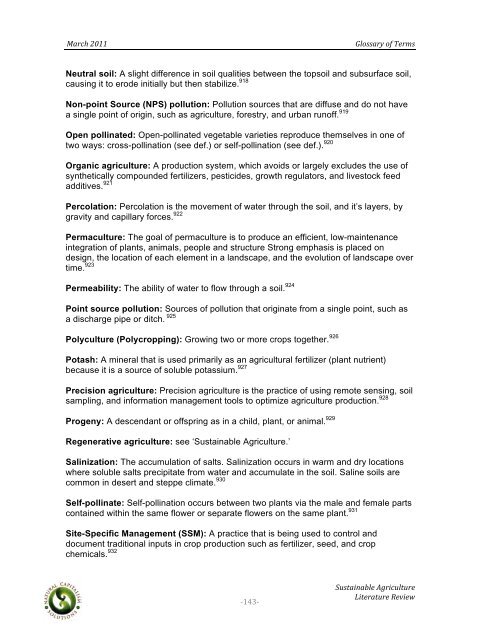Sustainable Agriculture Literature Review - Boulder County
Sustainable Agriculture Literature Review - Boulder County
Sustainable Agriculture Literature Review - Boulder County
You also want an ePaper? Increase the reach of your titles
YUMPU automatically turns print PDFs into web optimized ePapers that Google loves.
! !!<br />
"#$%&!'())!! !!!!!!!!!!!!!!!!!!!!!!!!!!!!!!!!!!!!!!!!!!!!!!!!!!!!!!!!!!!!!!!!I/-44#$F!-J!K1$B4!<br />
Neutral soil: A slight difference in soil qualities between the topsoil and subsurface soil,<br />
causing it to erode initially but then stabilize. 918<br />
Non-point Source (NPS) pollution: Pollution sources that are diffuse and do not have<br />
a single point of origin, such as agriculture, forestry, and urban runoff. 919<br />
Open pollinated: Open-pollinated vegetable varieties reproduce themselves in one of<br />
two ways: cross-pollination (see def.) or self-pollination (see def.). 920<br />
Organic agriculture: A production system, which avoids or largely excludes the use of<br />
synthetically compounded fertilizers, pesticides, growth regulators, and livestock feed<br />
additives. 921<br />
Percolation: Percolation is the movement of water through the soil, and it’s layers, by<br />
gravity and capillary forces. 922<br />
Permaculture: The goal of permaculture is to produce an efficient, low-maintenance<br />
integration of plants, animals, people and structure Strong emphasis is placed on<br />
design, the location of each element in a landscape, and the evolution of landscape over<br />
time. 923<br />
Permeability: The ability of water to flow through a soil. 924<br />
Point source pollution: Sources of pollution that originate from a single point, such as<br />
a discharge pipe or ditch. 925<br />
Polyculture (Polycropping): Growing two or more crops together. 926<br />
Potash: A mineral that is used primarily as an agricultural fertilizer (plant nutrient)<br />
because it is a source of soluble potassium. 927<br />
Precision agriculture: Precision agriculture is the practice of using remote sensing, soil<br />
sampling, and information management tools to optimize agriculture production. 928<br />
Progeny: A descendant or offspring as in a child, plant, or animal. 929<br />
Regenerative agriculture: see ‘<strong>Sustainable</strong> <strong>Agriculture</strong>.’<br />
Salinization: The accumulation of salts. Salinization occurs in warm and dry locations<br />
where soluble salts precipitate from water and accumulate in the soil. Saline soils are<br />
common in desert and steppe climate. 930<br />
Self-pollinate: Self-pollination occurs between two plants via the male and female parts<br />
contained within the same flower or separate flowers on the same plant. 931<br />
Site-Specific Management (SSM): A practice that is being used to control and<br />
document traditional inputs in crop production such as fertilizer, seed, and crop<br />
chemicals. 932<br />
!<br />
"'*)"<br />
!,342#.5#6/1!78$.%3/23$1!<br />
9.21$#23$1!:1;.1
















